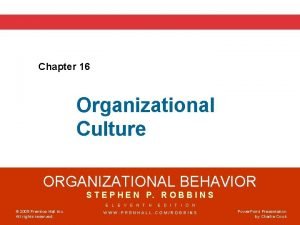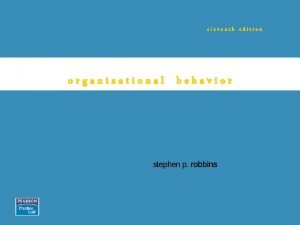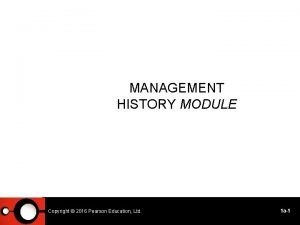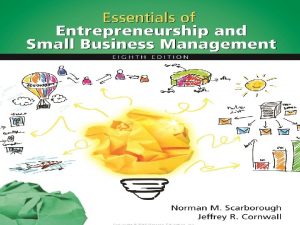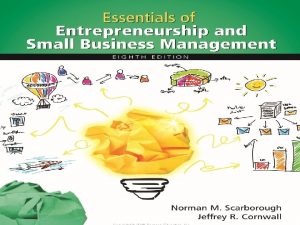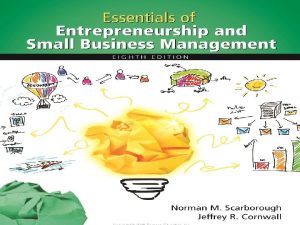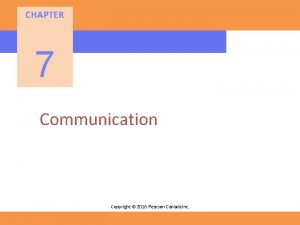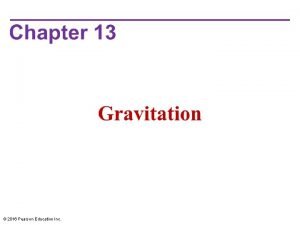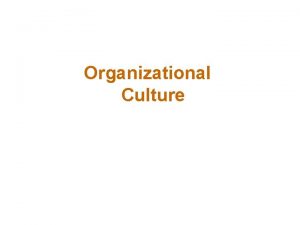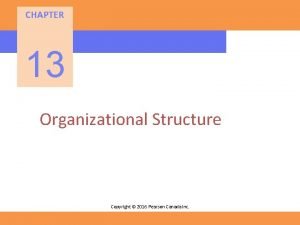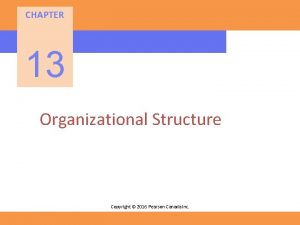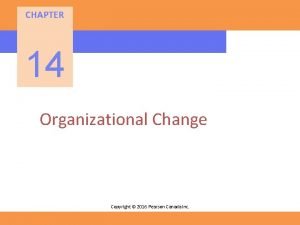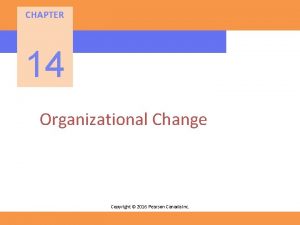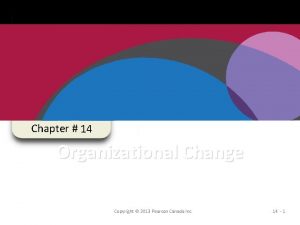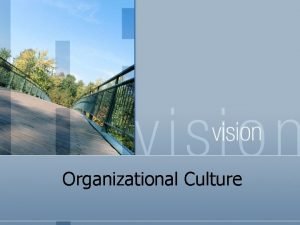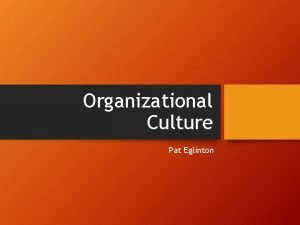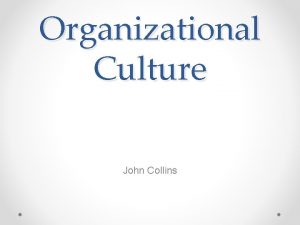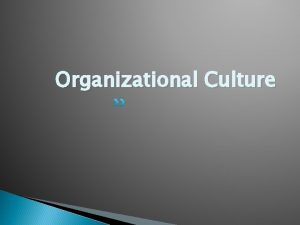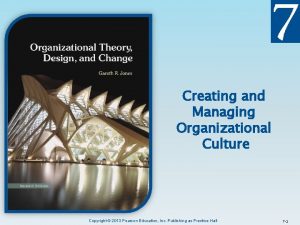CHAPTER 10 Organizational Culture Copyright 2016 Pearson Canada








































- Slides: 40

CHAPTER 10 Organizational Culture Copyright © 2016 Pearson Canada Inc.

Chapter Outline • What Is Organizational Culture? – Definition of Organizational Culture – Levels of Culture – Culture’s Functions – Culture Creates Climate – The Ethical Dimension of Culture – Do Organizations Have Uniform Cultures? – Strong vs. Weak Cultures Copyright © 2016 Pearson Canada Inc.

Chapter Outline • Reading an Organization’s Culture – Stories – Rituals – Material Symbols – Language • Creating and Sustaining Culture – How a Culture Begins – Keeping a Culture Alive Copyright © 2016 Pearson Canada Inc.

Chapter Outline • Creating and Sustaining Culture – How a Culture Begins – Keeping a Culture Alive • The Liabilities of Organizational Culture – Barrier to Change – Barrier to Diversity – Barrier to Mergers and Acquisitions • Changing Organizational Culture – Creating an Ethical Organizational Culture – Creating a Positive Organizational Culture Copyright © 2016 Pearson Canada Inc.

Learning Outcomes 1. Describe the common characteristics of organizational culture. 2. Identify the functional effects of organizational culture on people and the organization. 3. Identify the factors that create and sustain an organization’s culture. 4. Show culture is transmitted to employees. Copyright © 2016 Pearson Canada Inc.

Learning Outcomes 5. Identify the liabilities of organizational culture. 6. Demonstrate how an ethical organizational culture can be created. 7. Describe a positive organizational culture. Copyright © 2016 Pearson Canada Inc.

Henry Mintzberg on Culture • “Culture is the soul of the organization — the beliefs and values, and how they are manifested. I think of the structure as the skeleton, and as the flesh and blood. And culture is the soul that holds the thing together and gives it life force. ” Copyright © 2016 Pearson Canada Inc.

Organizational Culture • Refers to a system of shared meaning held by members that distinguishes the organization from other organizations Copyright © 2016 Pearson Canada Inc.

Organizational Culture • Seven primary characteristics of an organization’s culture: – Innovation and risk-taking. – Attention to detail. – Outcome orientation. – People orientation. – Team orientation. – Aggressiveness. – Stability. Copyright © 2016 Pearson Canada Inc.

Characteristics of Organizational Culture • Innovation and risk-taking – The degree to which employees are encouraged to be innovative and take risks. • Attention to detail – The degree to which employees are expected to exhibit precision, analysis, and attention to detail. • Outcome orientation – The degree to which management focuses on results or outcomes rather than on technique and process. • People orientation – The degree to which management decisions take into consideration the effect of outcomes on people within the organization. Copyright © 2016 Pearson Canada Inc.

Characteristics of Organizational Culture • Team orientation – The degree to which work activities are organized around teams rather than individuals. • Aggressiveness – The degree to which people are aggressive and competitive rather than easygoing. • Stability – The degree to which organizational activities emphasize maintaining the status quo in contrast to growth. Copyright © 2016 Pearson Canada Inc.

Exhibit 10 -1 Contrasting Organizational Cultures Copyright © 2016 Pearson Canada Inc.

Levels of Culture • Artifacts – Aspects of an organization’s culture that you see, hear, and feel. • Beliefs – The understandings of how objects and ideas relate to each other. • Values – The stable, long-lasting beliefs about what is important. • Assumptions – The taken-for-granted notions of how something should be in an organization. Copyright © 2016 Pearson Canada Inc.

Exhibit 10 -2 Layers of Culture Copyright © 2016 Pearson Canada Inc.

Culture’s Functions • Social glue that helps hold an organization together. – Enhances social system stability and provides appropriate standards for what employees should say or do. – Boundary-defining. – Conveys a sense of identity for organization members. – Facilitates commitment to something larger than one’s individual self-interest. – Guides and shapes the attitudes and behaviour of employees and serves as a “sense-making” and control mechanism. Copyright © 2016 Pearson Canada Inc.

Decentralized Organizations & Culture • Today’s trend toward decentralized organizations makes culture more important than ever, but it also makes establishing a strong culture more difficult. – Employees organized in teams may show greater allegiance to their team and its values than to the values of the organization as a whole. – In virtual organizations, the lack of frequent face-to-face contact makes establishing a common set of norms very difficult. • Strong leadership that communicates frequently about common goals and priorities is especially important in innovative organizations. Copyright © 2016 Pearson Canada Inc.

Culture Creates Climate • Organizational climate – refers to the shared perceptions organizational members have about their organization and work environment. – team spirit at the organizational level • When everyone has the same general feelings about what is important or how well things are working, the effect of these attitudes will be more than the sum of the individual parts. Copyright © 2016 Pearson Canada Inc.

Ethical Dimension of Culture • Organizational cultures are not ethically neutral • Ethical work climate (EWC) – Forms over time as part of the organizational climate – Shared concept of right and wrong behaviour in the workplace Copyright © 2016 Pearson Canada Inc.

Ethical Dimension of Culture • Ethical climate theory (ECT) and Ethical climate index (ECI) – Categorize and measure the ethical dimensions of organizational cultures – Ethical climate reflects the true values of the organization and shapes the ethical decision-making of its members • Five climate categories most prevalent: – – – Instrumental Caring Independence Law and code Rules Copyright © 2016 Pearson Canada Inc.

Do Organizations Have Uniform Cultures? • Organizational culture represents a common perception held by the organization members. • Core values or dominant (primary) values are accepted throughout the organization. – Dominant culture • Expresses the core values that are shared by a majority of the organization’s members. – Subcultures • Tend to develop in large organizations to reflect common problems, situations, or experiences. Copyright © 2016 Pearson Canada Inc.

Strong vs. Weak Cultures • Strong Cultures – the organization’s core values are both intensely held and widely shared. – have a great influence on the behaviour of its members – builds cohesiveness, loyalty, and organizational commitment Copyright © 2016 Pearson Canada Inc.

Reading an Organization’s Culture • Stories • Rituals • Material Symbols • Language Copyright © 2016 Pearson Canada Inc.

Exhibit 10 -3 How Organizational Cultures Form Copyright © 2016 Pearson Canada Inc.

Keeping a Culture Alive • Selection – Identify and hire individuals who will fit in with the culture. • Top Management – Senior executives establish and communicate the norms of the organization. • Socialization – Organizations need to teach the culture to new employees. Copyright © 2016 Pearson Canada Inc.

A Socialization Model • Prearrival stage – explicitly recognizes that each individual arrives with a set of values, attitudes, and expectations about both the work to be done and the organization. • Encounter Stage – confronts the possibility that expectations—of the job, coworkers, and the organization in general—may differ from reality. • Metamorphosis Stage – the new employee changes or goes through the metamorphosis stage. Outcomes: Productivity, Commitment, Turnover Copyright © 2016 Pearson Canada Inc.

Exhibit 10 -4 A Socialization Model Copyright © 2016 Pearson Canada Inc.

Entry Socialization Options • Formal vs. Informal • Individual vs. Collective • Fixed vs. Variable • Serial vs. Random • Investiture vs. Divestiture Copyright © 2016 Pearson Canada Inc.

Exhibit 10 -5 Entry Socialization Options Copyright © 2016 Pearson Canada Inc.

The Liabilities of Organizational Culture • Culture can have dysfunctional aspects in some instances. – Barrier to Change • When organization is undergoing change, culture may impede change. – Barrier to Diversity • Strong cultures put considerable pressure on employees to conform. – Barrier to Mergers and Acquisitions • Merging the cultures of two organizations can be difficult, if not impossible. Copyright © 2016 Pearson Canada Inc.

Strategies For Merging Cultures • Assimilation – The entire new organization is determined to take on the culture of one of the merging organizations. • Separation – Organizations remain separate and cultures are maintained. • Integration – A new hybrid culture is formed. Copyright © 2016 Pearson Canada Inc.

Changing Organizational Culture • Trying to change the culture of an organization is quite difficult and requires that many aspects of the organization change at the same time, especially the reward structure. • Culture is such a challenge to change because it often represents the established mindset of employees and managers. Copyright © 2016 Pearson Canada Inc.

Changing Organizational Culture Change is most likely when most or all of the following conditions exist: • • A dramatic crisis Turnover in leadership Young and small organizations Weak culture Copyright © 2016 Pearson Canada Inc.

Creating an Ethical Culture • • • Be a visible role model. – Employees will look to the actions of top management as a benchmark for appropriate behaviour. Communicate ethical expectations. – Minimize ethical ambiguities by creating and disseminating an organizational code of ethics. Provide ethics training. – Set up seminars, workshops, and similar ethics training programs. – Include in managers’ performance appraisals a point-by-point evaluation of how their decisions measured against the organization’s code of ethics. Visibly reward ethical acts and punish unethical ones. Provide protective mechanisms. – Provide formal mechanisms so employees can discuss ethical dilemmas and report unethical behaviour without fear of reprimand. Copyright © 2016 Pearson Canada Inc.

Creating a Positive Organizational Culture • Building on employee strengths • Rewarding more than punishing. • Emphasizing vitality and growth. • Limits of positive culture. Copyright © 2016 Pearson Canada Inc.

Global Implications • Organizational cultures often reflect national culture. • When an organization opens up operations in another country, it ignores the local culture at its own risk. • Management of ethical behaviour is one area where national culture can rub up against corporate culture. – Many strategies for improving ethical behaviour are based on the values and beliefs of the host country. Copyright © 2016 Pearson Canada Inc.

Summary 1. Reward systems generally signal the parts of the organization that are valued. 2. Culture can have both positive and negative effects on organizations. 3. Organizational culture can make change difficult, if not impossible. Copyright © 2016 Pearson Canada Inc.

OB at Work: For Review 1. What is organizational culture, and what are its common characteristics? 2. What are the functional effects of organizational culture on people and the organization? 3. What factors create and sustain an organization’s culture? 4. How is culture transmitted to employees? 5. What are the liabilities of organizational culture? 6. How can an ethical organizational culture be created? 7. What is a positive organizational culture? Copyright © 2016 Pearson Canada Inc.

OB at Work: For Managers ■ Realize that an organization’s culture is relatively fixed in the short term. To effect change, involve top management and strategize a long-term plan. ■ Hire individuals whose values align with those of the organization; these employees will tend to remain committed and satisfied. Not surprisingly, “misfits” have considerably higher turnover rates. Copyright © 2016 Pearson Canada Inc.

OB at Work: For Managers ■ Understand that employees’ performance and socialization depend to a considerable degree on their knowing what to do and not do. Train your employees well and keep them informed of changes to their job roles. ■ Be aware that your company’s organizational culture may not be “transportable” to other countries. Understand the cultural relevance of your organization’s norms before introducing new plans or initiatives overseas. Copyright © 2016 Pearson Canada Inc.

Breakout Group Exercises • Form small groups to discuss the following: 1. Choose two courses that you are taking this term, ideally in different faculties, and describe the culture of the classroom in each. What are the similarities and differences? What values about learning might you infer from your observations of culture? 2. Identify artifacts of culture in your current or previous workplace. From these artifacts, would you conclude that the organization had a strong or weak culture? 3. Have you or someone you know worked somewhere the culture was strong? What was your reaction to that strong culture? Did you like that environment, or would you prefer to work where there is a weaker culture? Why? Copyright © 2016 Pearson Canada Inc.
 Customer responsive culture
Customer responsive culture Customer responsive organization
Customer responsive organization 2016 pearson education inc
2016 pearson education inc 2016 pearson education inc
2016 pearson education inc 2016 pearson education inc
2016 pearson education inc 2016 pearson education inc
2016 pearson education inc 2016 pearson education inc
2016 pearson education inc 2016 pearson education inc
2016 pearson education inc 2016 pearson education inc
2016 pearson education inc 2016 pearson education inc
2016 pearson education inc 2016 pearson education inc
2016 pearson education inc 2016 pearson education inc
2016 pearson education inc 2016 pearson education inc
2016 pearson education inc 2016 pearson education inc
2016 pearson education inc 2016 pearson education inc
2016 pearson education inc 2016 pearson education inc
2016 pearson education inc 2017 pearson education ltd
2017 pearson education ltd Copyright by pearson education inc. answers
Copyright by pearson education inc. answers 2010 pearson education inc
2010 pearson education inc 2009 pearson education inc
2009 pearson education inc Copyright pearson education inc
Copyright pearson education inc Copyright 2014 pearson education inc
Copyright 2014 pearson education inc Copyright 2010 pearson education inc
Copyright 2010 pearson education inc Copyright 2010 pearson education inc
Copyright 2010 pearson education inc Copyright by pearson education inc. answers
Copyright by pearson education inc. answers Copyright 2003 pearson education inc
Copyright 2003 pearson education inc 2005 pearson prentice hall inc
2005 pearson prentice hall inc Copyright 2009 pearson education inc
Copyright 2009 pearson education inc 2015 pearson education inc
2015 pearson education inc Copyright 2010 pearson education inc
Copyright 2010 pearson education inc Copyright 2010 pearson education inc
Copyright 2010 pearson education inc Copyright 2010 pearson education inc
Copyright 2010 pearson education inc 2010 pearson education inc
2010 pearson education inc Copyright 2010 pearson education inc
Copyright 2010 pearson education inc Copyright 2010 pearson education inc
Copyright 2010 pearson education inc Copyright 2010 pearson education inc
Copyright 2010 pearson education inc Copyright 2009 pearson education inc
Copyright 2009 pearson education inc 2009 pearson education inc
2009 pearson education inc Copyright 2009 pearson education inc
Copyright 2009 pearson education inc 2009 pearson education inc
2009 pearson education inc Copyright pearson education inc
Copyright pearson education inc
